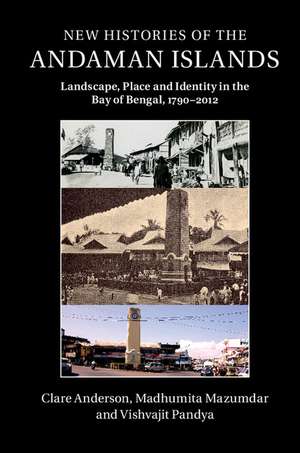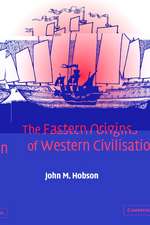New Histories of the Andaman Islands: Landscape, Place and Identity in the Bay of Bengal, 1790–2012
Autor Clare Anderson, Madhumita Mazumdar, Vishvajit Pandyaen Limba Engleză Hardback – 10 feb 2016
| Toate formatele și edițiile | Preț | Express |
|---|---|---|
| Paperback (1) | 238.90 lei 6-8 săpt. | |
| Cambridge University Press – 7 mar 2018 | 238.90 lei 6-8 săpt. | |
| Hardback (1) | 699.86 lei 6-8 săpt. | |
| Cambridge University Press – 10 feb 2016 | 699.86 lei 6-8 săpt. |
Preț: 699.86 lei
Preț vechi: 786.36 lei
-11% Nou
Puncte Express: 1050
Preț estimativ în valută:
133.93€ • 139.03$ • 111.68£
133.93€ • 139.03$ • 111.68£
Carte tipărită la comandă
Livrare economică 24 martie-07 aprilie
Preluare comenzi: 021 569.72.76
Specificații
ISBN-13: 9781107076792
ISBN-10: 110707679X
Pagini: 333
Ilustrații: 29 b/w illus.
Dimensiuni: 158 x 235 x 20 mm
Greutate: 0.67 kg
Editura: Cambridge University Press
Colecția Cambridge University Press
Locul publicării:New York, United States
ISBN-10: 110707679X
Pagini: 333
Ilustrații: 29 b/w illus.
Dimensiuni: 158 x 235 x 20 mm
Greutate: 0.67 kg
Editura: Cambridge University Press
Colecția Cambridge University Press
Locul publicării:New York, United States
Cuprins
1. Introduction; Part I. Contentious Landscapes: 2. Improving visions, troubled landscapes: the legacies of colonial Ferrargunj; 3. Entangled struggles, contested histories: the Second World War and after; 4. The making of a 'rhizomatic' landscape: place, space and the politics of memory in the Andamanese Islands; Part II. Affective Landscapes: 5. The Andaman local born: history, identity and convict descent; 6. Dwelling in fluid spaces: the Matuas of the Andaman Islands; 7. In pursuit of fireflies: the poetics and politics of 'lightscapes' in the Jarawa forests; Part III. Imagined Landscapes: 8. Visual representations of the penal colony; 9. Endangered landscapes, dream destinations: the shifting frames of 'tropicality' in the Andaman Islands; 10. Conclusion; Bibliography; Index.
Recenzii
'This brilliant and groundbreaking book is an interdisciplinary collaboration between three leading scholars. It situates the Andaman Islands within multiple scales of imperial and national history, while remaining deeply attentive to the textures of local society. It will be essential reading for scholars of modern South Asia and the Indian Ocean, historians of imperialism, and historians of global migration.' Sunil Amrith, Harvard University, Massachusetts
'The Andaman Islands are the 'entangled landscape' par excellence. The authors, two historians and an anthropologist, collaborate to unravel the tangles in this fascinating study. These distant islands, lying far south of Burma in the Bay of Bengal, symbolize remoteness. Home of indigenous people who stood as the representative 'primitive' hunter-gatherers to generations of anthropologists, the Andamans were turned into a laboratory of colonial experiments. First a penal colony for common criminals, then the place of exile for 1857 'mutineers', then a prison for freedom fighters, the Andamans were captured by Japan during World War II. After the War and Indian independence, the government has sought to make this distant territory a refuge for people displaced by Partition, a 'normal' part of India, and a tourist destination. As the wide-ranging scholarship of this book demonstrates, every step taken over more than two centuries has created yet another tangle in this landscape.' Ralph W. Nicholas, University of Chicago
'Landscape and settlement, memory and narrative, the visual, the archival and the experiential - all come together in this remarkable, multidisciplinary account of the making of the modern Andamans. The authors radically transform our understanding of these islands, their complex histories and intersecting ethnographies and their equivocal place in empire and nation.' David Arnold, University of Warwick
'Drawing inspiration from the disciplines of history, anthropology and historical geography, this book presents a new perspective on the colonial and contemporary history of the Andaman Islands. In a series of compelling studies of landscape and memory, the authors combine archival and ethnographic approaches to explore the complex and contested processes of place-making through which the patterns of history take their shape and meaning in the present.' Felix Driver, Royal Holloway, University of London
'The joy of New Histories [of the Andaman Islands] lies in its plentiful and compelling detail of overlooked or occluded stories, events, places, and groups. … The book is at its best when dealing with the intimate, especially when demonstrating that intimacy need not be local and isolated but can involve long-distance materials and imaginings.' Thomas Simpson, Journal of Historical Geography
'… this volume undertakes a competent survey of the Andaman Islands' post-1923 social history and is a valuable addition to the burgeoning field of the social history of the Andamans …' Aparna Vaidik, The American Historical Review
'The Andaman Islands are the 'entangled landscape' par excellence. The authors, two historians and an anthropologist, collaborate to unravel the tangles in this fascinating study. These distant islands, lying far south of Burma in the Bay of Bengal, symbolize remoteness. Home of indigenous people who stood as the representative 'primitive' hunter-gatherers to generations of anthropologists, the Andamans were turned into a laboratory of colonial experiments. First a penal colony for common criminals, then the place of exile for 1857 'mutineers', then a prison for freedom fighters, the Andamans were captured by Japan during World War II. After the War and Indian independence, the government has sought to make this distant territory a refuge for people displaced by Partition, a 'normal' part of India, and a tourist destination. As the wide-ranging scholarship of this book demonstrates, every step taken over more than two centuries has created yet another tangle in this landscape.' Ralph W. Nicholas, University of Chicago
'Landscape and settlement, memory and narrative, the visual, the archival and the experiential - all come together in this remarkable, multidisciplinary account of the making of the modern Andamans. The authors radically transform our understanding of these islands, their complex histories and intersecting ethnographies and their equivocal place in empire and nation.' David Arnold, University of Warwick
'Drawing inspiration from the disciplines of history, anthropology and historical geography, this book presents a new perspective on the colonial and contemporary history of the Andaman Islands. In a series of compelling studies of landscape and memory, the authors combine archival and ethnographic approaches to explore the complex and contested processes of place-making through which the patterns of history take their shape and meaning in the present.' Felix Driver, Royal Holloway, University of London
'The joy of New Histories [of the Andaman Islands] lies in its plentiful and compelling detail of overlooked or occluded stories, events, places, and groups. … The book is at its best when dealing with the intimate, especially when demonstrating that intimacy need not be local and isolated but can involve long-distance materials and imaginings.' Thomas Simpson, Journal of Historical Geography
'… this volume undertakes a competent survey of the Andaman Islands' post-1923 social history and is a valuable addition to the burgeoning field of the social history of the Andamans …' Aparna Vaidik, The American Historical Review
Notă biografică
Descriere
A multidisciplinary exploration of the history of the Andaman Islands, blending history, sociology and anthropology.












